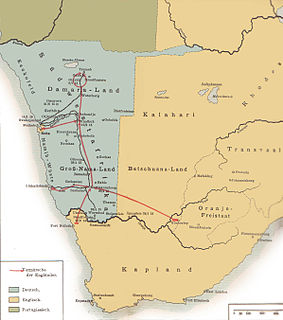Related Research Articles
Sextus Julius Africanus was a Christian traveler and historian of the late second and early third centuries. He is important chiefly because of his influence on Eusebius, on all the later writers of Church history among the Church Fathers, and on the whole Greek school of chroniclers.

Australopithecus is a genus of early hominins that existed in Africa during the Late Pliocene and Early Pleistocene. The genera Homo, Paranthropus, and Kenyanthropus evolved from Australopithecus. Australopithecus is a member of the subtribe Australopithecina, which also includes Ardipithecus, though the term "australopithecine" is sometimes used to refer only to members of Australopithecus. Species include A. garhi, A. africanus, A. sediba, A. afarensis, A. anamensis, A. bahrelghazali and A. deyiremeda. Debate exists as to whether some Australopithecus species should be reclassified into new genera, or if Paranthropus and Kenyanthropus are synonymous with Australopithecus, in part because of the taxonomic inconsistency.

The common warthog is a wild member of the pig family (Suidae) found in grassland, savanna, and woodland in sub-Saharan Africa. In the past, it was commonly treated as a subspecies of P. aethiopicus, but today that scientific name is restricted to the desert warthog of northern Kenya, Somalia, and eastern Ethiopia.

Joannes Leo Africanus was a Berber Andalusi diplomat and author who is best known for his book Descrittione dell’Africa centered on the geography of the Maghreb and Nile Valley. The book was regarded among his scholarly peers in Europe as the most authoritative treatise on the subject until the modern exploration of Africa. For this work, Leo became a household name among European geographers. He converted from Islam to Christianity and changed his name to Johannes Leo de Medicis.

The South West Africa Campaign was the conquest and occupation of German South West Africa by forces from the Union of South Africa acting on behalf of the British imperial government at the beginning of the First World War.

Australopithecus africanus is an extinct species of australopithecine which lived from 3.67 to 2 million years ago in the Middle Pliocene to Early Pleistocene of South Africa. The species has been recovered from Taung and the Cradle of Humankind at Sterkfontein, Makapansgat, and Gladysvale. The first specimen, the Taung child, was described by anatomist Raymond Dart in 1924, and was the first early hominin found. However, its closer relations to humans than to other apes would not become widely accepted until the middle of the century because most had believed humans evolved outside of Africa principally due to the hoax transitional fossil Piltdown Man from Britain. It is unclear how A. africanus relates to other hominins, being variously placed as ancestral to Homo and Paranthropus, to just Paranthropus, or to just P. robustus. The specimen "Little Foot" is the most completely preserved early hominin, with 90% of the skeleton intact, and the oldest South African australopith. However, it is controversially suggested that it and similar specimens be split off into "A. prometheus".
An agnomen, in the Roman naming convention, was a nickname, just as the cognomen was initially. However, the cognomina eventually became family names, so agnomina were needed to distinguish between similarly named persons. However, as the agnomen was an additional and optional component in a Roman name, not all Romans had an agnomen.

The African wild donkey or African wild ass is a wild member of the horse family, Equidae. This species is believed to be the ancestor of the domestic donkey, which is usually placed within the same species. They live in the deserts and other arid areas of the Horn of Africa, in Eritrea, Ethiopia and Somalia. It formerly had a wider range north and west into Sudan, Egypt, and Libya. About 570 individuals exist in the wild.

Tornieria is a genus of diplodocid sauropod dinosaur from Late Jurassic of Tanzania. It has a convoluted taxonomic history.

Asinus is a subgenus of Equus that encompasses several subspecies of the Equidae commonly known as wild asses, characterized by long ears, a lean, straight-backed build, lack of a true withers, a coarse mane and tail, and a reputation for considerable toughness and endurance.

The Battle of the Great Plains, also known as the Battle of the Bagrades, was a battle fought between Scipio Africanus of Rome and a combined Carthaginian and Numidian army late in the Second Punic War. It occurred on the plains south of Bulla Regia around the upper Bagradas River. The attack was designed as a diversionary tactic by Rome to disrupt Hannibal's attack on Italy. By defeating the Carthaginians, Scipio Africanus caused Hannibal to leave Italy and return to Africa, where he was later defeated at Zama.
Longidorus maximus is a plant pathogenic nematode.
Longidorus sylphus is a plant pathogenic nematode, which attacks mint.
Raspberry ringspot virus (RRSV) is a plant pathogenic virus of the family Secoviridae. It was first described by Cadman in 1958. It causes ringspots in raspberries and strawberries and can cause rasp-leaf symptoms in cherry. It also has been found in many other plants including those in the Vitis and Narcissus genera. There are many strains of the virus, the most important including the Scottish strain, the English strain, and the Lloyd George yellow blotch strain. The Scottish strain is the type virus.

Africanus Horton is a crater on Mercury. It was named by the IAU in 1976, after Africanus Horton, a Creole African nationalist writer and an esteemed medical surgeon in the British Army from Freetown, Sierra Leone.

The Roman army's mutiny at Sucro, a no longer existing ancient fort in Spain, took place in early 206 BC, during the Roman conquest of Hispania in the Second Punic War against Carthage. The mutineers had several grievances, including not having received the pay due to them and being under-supplied. The proximate causes of the mutiny had existed for years, but had not been addressed to the soldiers' satisfaction. Matters came to a head after rumors spread that their commanding general, Scipio Africanus, had become gravely ill. But the stories proved to be without foundation; he succeeded in suppressing the mutiny and executed its ringleaders.

Publius Cornelius Scipio Africanus was a Roman general and later consul who is often regarded as one of the best military commanders and strategists of all time. His main achievements were during the Second Punic War. His greatest military achievement was the defeat of Hannibal at the Battle of Zama in 202 BC. The victory was one of the feats that earned him the agnomen he is best known for: Africanus.
Longidorus is a genus of needle nematodes. Some of its species are plant pests.